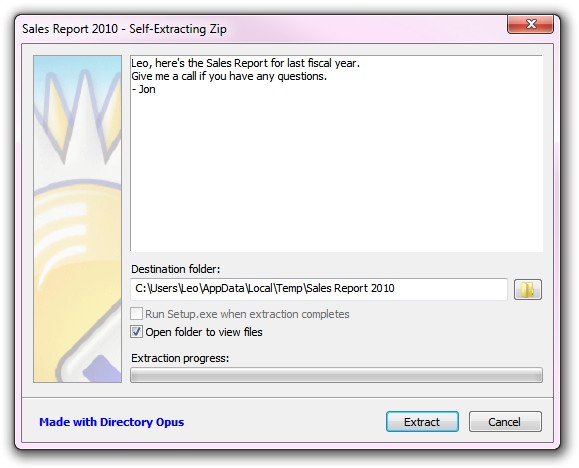Self-Extracting Zip Files
Opus lets you convert a Zip archive into what's called a self-extracting
archive. This turns an archive file (which needs another program to decompress
it) into an executable program that you can send to people. When they
run the program, an easy-to-use interface will guide them through extracting the
contents of the archive.
Now that Windows itself comes with built-in support for Zip files
self-extracting archives are not as widely used as they once were, but there are
still some uses for them.
To create a self-extracting archive, you must first create the source Zip archive. You can use the
Add to
Archive dialog to create a Zip archive and convert it to
self-extracting format in one step, or you can create the archive and then
convert it separately using the context menu command that Opus adds
automatically to the context menu for .zip files.

This context menu can be disabled through the Archive Context Menu Preferences page,
so if you don't see it when you right-click on a Zip file you may need to go and
turn it on.
The Create Self-Extracting Archive dialog gives you several
options that control the final self-extracting archive:
- From: This field displays the name of the Zip archive you
are converting.
- To: This specifies the path of the .exe
file the conversion process will create. This defaults to the same location
and name as the source archive, but with a .exe instead of
.zip extension.
- Name: This lets you configure a name that is displayed in
the title bar of the self-extractor when it's run.
- Custom instructions: If you check this box you are able
to select an external text file (.txt) to provide
instructions or a message that will be displayed in the self-extractor when
it's run. If you don't provide a file then default instructions are displayed.
- Custom image: If you check this box you can select an
external image file that is displayed on the left-hand side of the
self-extractor window. If you don't select this option a standard image is
used. If you turn this option on but don't select an image file then no image
at all will be used, which can reduce the size of the final
.exe file slightly.
- Default path for extraction: This lets you specify a
location that will be used as the default path the files in the archive are
extracted to when the self-extractor is run. The end-user will still be able
to modify the destination path; this is simply a default.
- Auto-run after extraction: If your archive contains any
executable programs, you can select one from the drop-down list to have that
file automatically run after the archive has been extracted. For developers,
you could use this to create a simple "installer" that extracts several files
and then runs an included Setup.exe-type program to perform the actual
installation.
Once you have chosen your parameters, click the OK button to
perform the actual conversion process. You should be left with a
.exe file slightly larger than the original Zip archive.
When someone runs your self-extracting archive, they will see a window
similar to this:

From this window you can deduce the parameters we set when creating the
extractor:
- The image on the left of the window is the default - we didn't specify
anything for Custom image when creating the self-extractor.
- The displayed text is the result of specifying a Custom
instructions file.
- We didn't specify a Default path for extraction, so the
default behavior is to extract to the temporary folder.
- We also didn't specify an Auto-run after extraction file,
so that option is disabled.
The Open folder to view files option is
user-controllable; if they select that then a window (from their default folder
browser) will be opened automatically to show the contents of the extracted
archive.
The extraction function handles UAC automatically under Vista and Windows 7.
If the user opts to extract to a UAC-protected location (like C:\Program
Files) they will be asked to elevate to approve the action.


